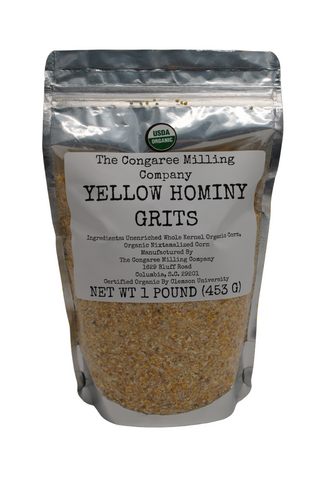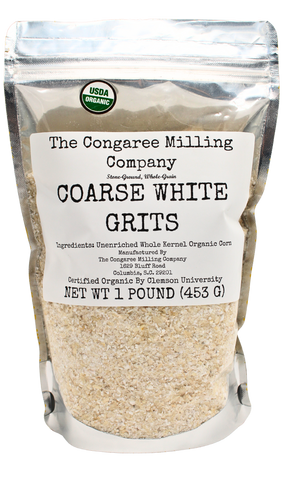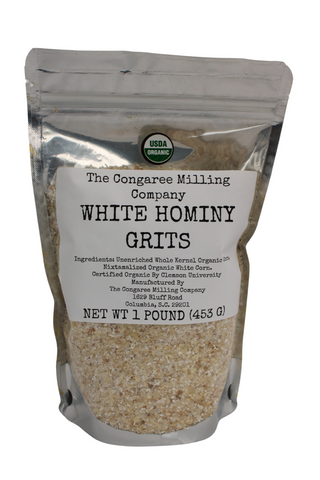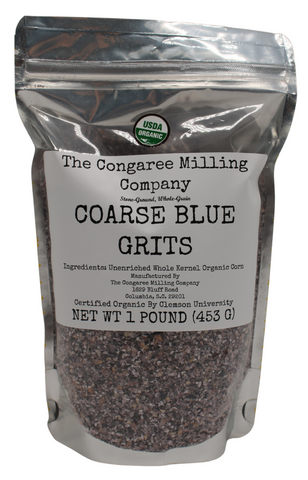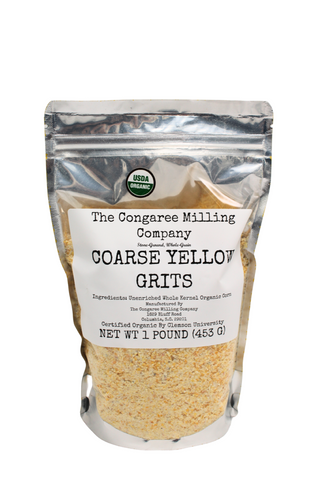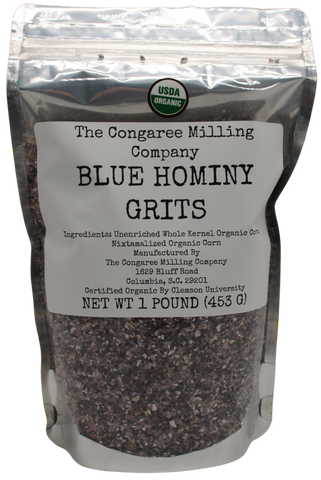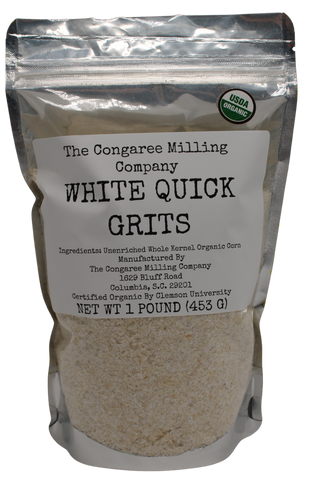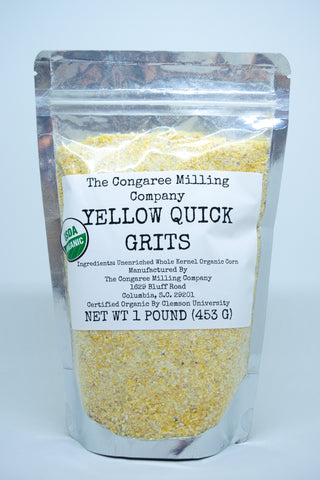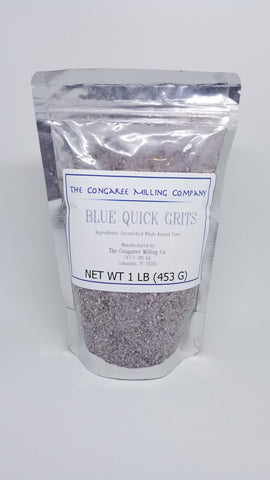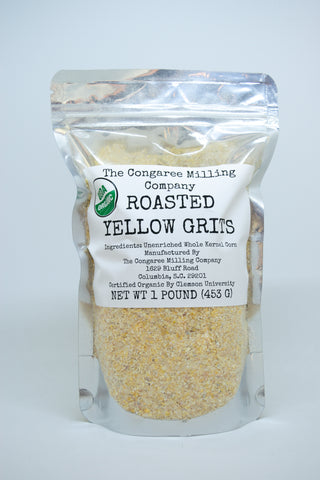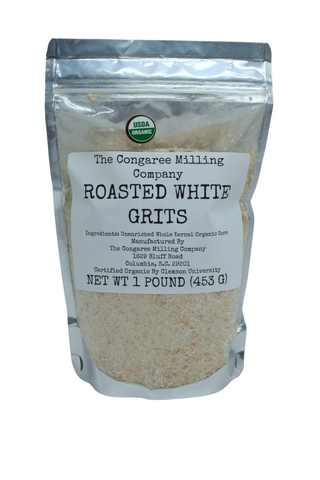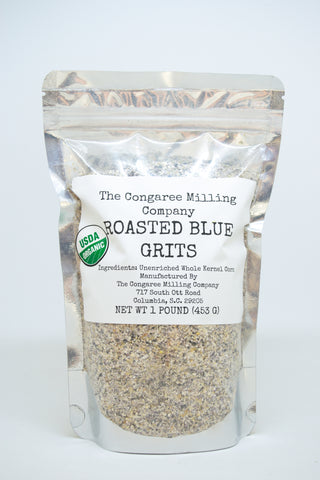Organic Stone-Ground Grits

Here is our selection of stone-ground organic grits. All of our products are freshly milled to order. Choose from Coarse Grits or Quick Grits, Roasted Grits, Hominy Grits, organic white corn, organic yellow corn, and organic blue corn grits.
What are grits? Grits are ground up corn. In this case, they are ground from organic corn using a stone-burr mill. Hence stone-ground organic grits. Coarse grits are precisely what they sound like: they contain coarse and chunky bits of endosperm. They are an old-fashioned food that can take up to an hour cook. Quick grits are smaller and take about a half hour. The different colors of grits simply indicate what color corn the grits are ground from. The Roasted Grits contain corn roasted (or "parched") in a brick oven. This creates a popcorn flavor along with a nuttiness that I think is reminiscent of peanut butter. Hominy grits contain nixtamalized corn that has been dried and ground on the stone-burr mill.
Corn is North America's only widespread native grain. It was the staple of almost all Native American agricultural civilizations. Corn was selectively bred from a native plant called tesointe.
When settlers arrived, they immediately started grinding this American grain on their mills, and grits were created. This makes grits a food that is a truly American invention, since most Native American cultures ate nixtamalized corn almost exclusively in their corn dishes. Grits are a combination of two technologies, one agricultural and Native American, one mechanical and European (although the stone-burr mill probably originated in Asia).
If you are curious as to what the flavor of nixtamal is like, you may be surprised to know are probably already familiar with it!
Corn tortillas are nixtamalized corn, as are tamales. This is unsurprising, since Mexican food is heavily influenced by Native American culture.
Some more observant settlers knew the nutritional and culinary value of nixtamalization, and they started milling hominy grits.
"Hominy grits" is a term used loosely, and often inaccurately. Several techniques for making hominy grits can be used, but if there is no nixtamalization, they are not hominy grits.
Check out my rendition of this often misunderstood kind of grits here.
I don't mill your grits until I fulfill your order. Why does this matter? All of my products are whole-grain, and this means they aren't the shelf stable, flavorless (or worse, rancid) milled goods that have been sitting on the grocery store shelf since who knows when. The difference is not only in the freshly-milled flavor, but in the nutritional value.
Whole grain products are an essential part of a balanced diet. As the scientific evidence grows relating to the importance of gut bacteria, scientists have discovered that resistant starch is essential for the fermentation that your gut bacteria feeds on. Since resistant starch isn't absorbed in the small intestine, it doesn't raise blood glucose levels (unlike simple, refined starches). This makes resistant starch essential to maintaining a healthy body weight. Whole-grain grits are by far the most resistant starch-abundant food available.
Grits make a healthy and flavorful alternative to potatoes and pasta, or any starch, and can be served as porridge, grilled, or fried. But no matter how you serve them, they must be cooked in liquid first. Water works fine, but more flavor can be added by cooking them in stock (vegetable stock, chicken stock, beef stock, and pork stock all work quite well, as does bullion and bases). Additionally, any kind of milk can be added to your liquid (I wouldn't recommend chocolate milk, though). This includes skim milk (if that's what you like), but I go for whole milk, half and half, or heavy cream. I've found that if I start with any kind of milk, I achieve the best results by thinning the milk with some water.
There are only a few essential rules for cooking grits:
- Add salt early on. At the start. You can even salt the water, although I recommend "washing" your grits before bringing them to a boil. 1 teaspoon of salt per dry cup of grits is a good start. You can always add more before serving. Without this initial seasoning of salt, It seems they never get salty enough.
- Don't burn your grits! I've burned many a pot of grits, so I speak from experience. Honestly, you may as well start over. It is not at all unlike burning a batch of popcorn. Keep the heat low, and be patient. On low heat, you won't need stir the grits but every few minutes. Grits hold well on the stovetop and can be reheated fairly easily (again, don't burn them). So plan ahead if you are cooking coarse grits. They take time. And especially if you are pairing your grits with seafood, which cooks very quickly.
- Cook them until they are done. Individual tastes vary, but I like mine totally soft. Not every lot of corn is the same, and grits from different mill runs can vary for this and other reasons. there's only one way to see if your grits are done: try them. If the grits aren't soft and they need more time, but they are thickening up, add a little liquid. DON'T BURN YOUR MOUTH WHEN YOU TASTE THEM!
Lastly, Please store all of my products in a cool, dry place. The freezer is the best place for long-term storage. There is no need to defrost my products before you use them if you store them in this manner.

